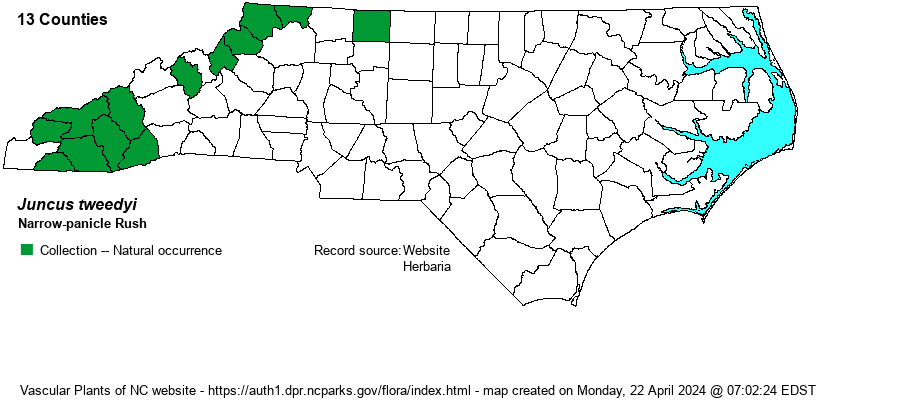| Author | Rydberg | |
| Distribution | Mountains almost exclusively; also Stokes County (Hanging Rock State Park) in the northwestern Piedmont.
Newf. to Man., south to PA and MN; southward in the mountains to NC (and reportedly GA). Also scattered in the West from Alb. to CO and AZ. | |
| Abundance | Uncommon to locally infrequent in the Mountains; very rare in the northern Piedmont foothills. This is a Watch List species. The NCNHP's State Rank of S1? seems overly conservative, considering that there are collection records for at least 13 counties. The website editors suggest S2S3. | |
| Habitat | Montane seepage bogs, impoundment margins, beaver pond margins. | |
| Phenology | Flowering and fruiting July-September. | |
| Identification | Narrow-panicle Rush has rather rounded heads (sometimes hemispherical) like a number of other NC rushes. Its seeds have whitish "tails" at each end as do J. canadensis, J. brachycephalus, and J. trigonocarpus (but unlike other NC species). It differs from canadensis by shorter tails and the fact that tepals are shorter than the mature capsule (vs. about the same). It differs from brachycephalus, which is reported for NC but no specimens have been verified, by acuminate or acute tepals (vs. blunt to weakly acute). J. trigonocarpus occurs essentially in the NC Sandhills region, with no overlap with this essentially montane species. | |
| Taxonomic Comments | Weakley (2023) gives the reason for renaming the former J. brevicaudatus as now J. tweedyi. In some texts, treated as a variety of J. canadensis.
NOTE on Juncus: These "grasslike" or "sedgelike" plants occur in most habitats, especially where moist or wet. They can immediately be told from grasses and sedges by the presence of 6 tepals (petal-like) that surround the fruit. These tepals can be thought of as analogous to sepals and petals of, say, lilies or trilliums. Most species have brown, chestnut, or reddish tepals and dark brown fruits. The flowers occur in few- to many-flowered heads. Leaves are nearly all basal and round in cross-section. Stems are unbranched, except for the inflorescence. Fruits are termed capsules and contain many tiny seeds. | |
| Other Common Name(s) | Short-tailed Rush | |
| State Rank | S1? [S2S3] | |
| Global Rank | G5 | |
| State Status | W7 [W1] | |
| US Status | | |
| USACE-agcp | | |
| USACE-emp | | |

